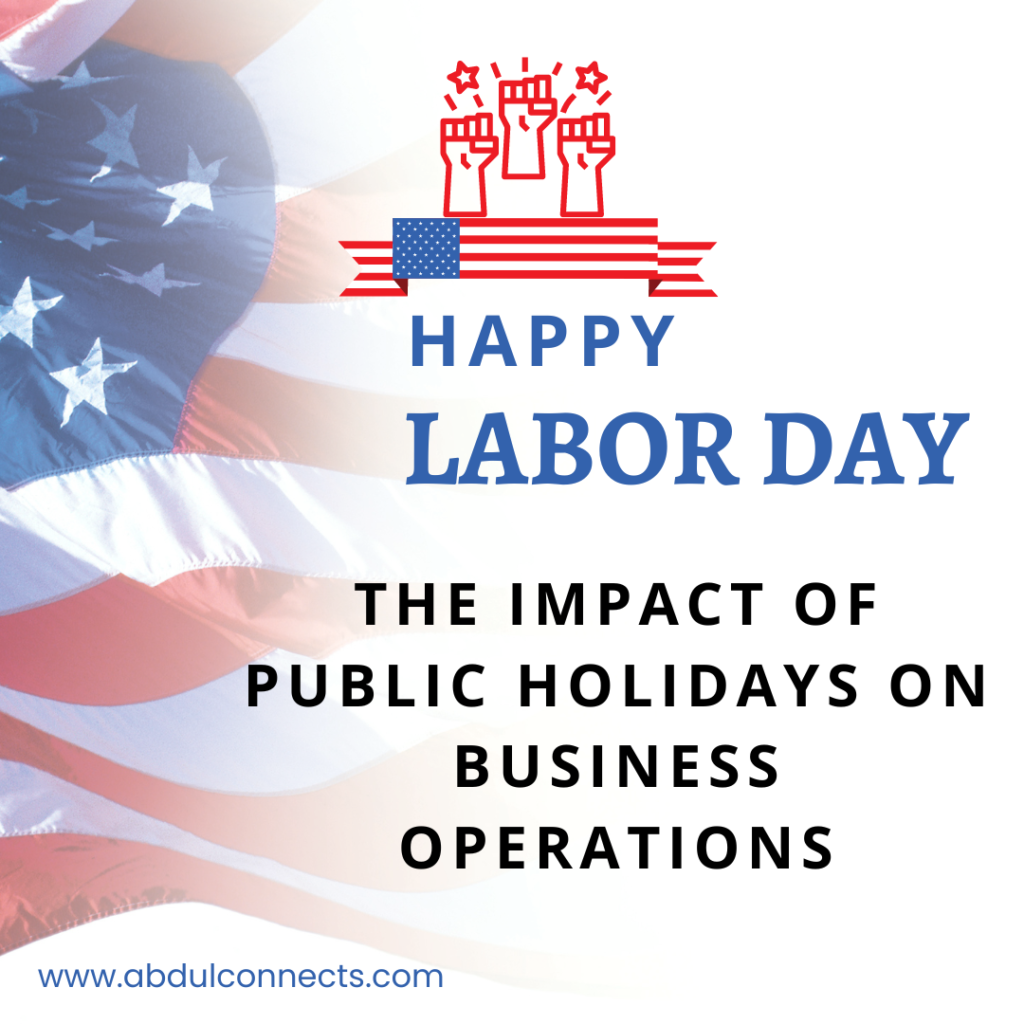
Now a Days Public holidays are more than just days off; they are events that can significantly shape the way businesses are operating. These days bring about a mix of opportunities and challenges that can have far-reaching effects on both consumer behavior and business performance. Understanding these impacts is really really crucial for business owners who are aiming to maximize the benefits while minimizing the drawbacks of public holidays.
Positive Impacts of Public Holidays ( USA Labor Day )
- Surge in Consumer Spending
Public holidays are often associated with an uptick in consumer spending. During these times, people are more likely to spend on goods and services, particularly in sectors like retail, hospitality, and tourism. For instance, the Thanksgiving holiday in the United States is a prime example, where retailers experience a massive surge in sales as consumers purchase food, gifts, and decorations in preparation for family gatherings. This increase in spending can provide a significant boost to businesses, driving revenues higher than usual.
- Unique Marketing Opportunities
Public holidays can be a golden opportunity for businesses to engage with their customers through targeted marketing campaigns. These occasions allow businesses to align their products and services with the holiday spirit, creating themed promotions that resonate with the public. For example, a restaurant might introduce a special menu to celebrate Independence Day, drawing in customers who are looking to dine out as part of their festivities. Similarly, retail stores can run holiday sales or limited-time offers that attract shoppers. These marketing efforts not only increase sales but also enhance brand visibility and customer loyalty.
- Boost in Employee Morale
Holidays provide employees with much-needed time off, allowing them to relax and recharge. This break from the daily grind can lead to improved job satisfaction and a more motivated workforce. When employees return to work after a holiday, they are often more productive and engaged, which can enhance overall operational efficiency. A happy and rested team is more likely to perform at their best, contributing positively to the business’s success.
Negative Impacts of Public Holidays
- Disruption of Productivity
While holidays can boost morale, they can also disrupt business operations, especially in industries that require continuous output, such as manufacturing, logistics, or customer support. Small and medium-sized enterprises (SMEs) may find it particularly challenging to manage workloads during these periods. Unfinished tasks, delayed projects, and missed deadlines can all result from the disruption caused by holidays, potentially affecting service quality and customer satisfaction.
- Increased Labor Costs
For businesses that choose to remain open during public holidays, the financial implications can be significant. Labor laws in many countries require businesses to pay employees extra for working on holidays, often in the form of overtime or holiday pay. For smaller businesses with limited budgets, these increased labor costs can be a strain on finances. Balancing the need to stay operational with the added expense can be a delicate challenge.
- Supply Chain Disruptions
Public holidays can also lead to interruptions in the supply chain. With many businesses closed for the holiday, deliveries may be delayed, and production schedules disrupted. This can create bottlenecks, leading to shortages of materials or products and ultimately affecting the business’s ability to meet customer demand. Proper planning and communication with suppliers are essential to navigate these disruptions effectively.
Strategies for Managing the Impact of Public Holidays
Given the potential challenges that public holidays can present, businesses must adopt proactive strategies to manage their impact effectively. Here are some key approaches:
- Advanced Planning
One of the most effective ways to mitigate the impact of public holidays is through careful and advanced planning. Creating a comprehensive calendar that outlines all upcoming public holidays and their potential effects on business operations allows managers to allocate resources appropriately and adjust timelines as needed. This planning ensures that the business is prepared to handle any disruptions while also capitalizing on the opportunities that holidays present.
- Flexible Work Arrangements
Offering flexible work arrangements, such as remote work or adjusted schedules, can help maintain productivity during holiday periods. By allowing employees to work from home or adjust their hours, businesses can ensure that essential tasks are completed without overburdening staff. This flexibility not only helps keep operations running smoothly but also contributes to higher employee satisfaction, as staff appreciate the accommodation of their personal needs.
- Leveraging Technology
In today’s digital age, technology plays a crucial role in keeping businesses connected and organized, even during busy holiday periods. Utilizing project management tools, communication platforms, and other digital resources can streamline operations and ensure that all team members are on the same page. For example, cloud-based project management software allows teams to collaborate and track progress in real-time, even if some members are out of the office. This technological support is vital for maintaining efficiency and avoiding the pitfalls of holiday disruptions.
- Strategic Marketing and Promotions
To make the most of the increased consumer activity during holidays, businesses should plan their marketing campaigns well in advance. Developing holiday-themed promotions that resonate with your target audience can drive significant engagement and sales. Social media and email marketing are powerful tools for reaching customers during these times. By scheduling posts and emails to go out during the holiday, businesses can maintain a strong presence and encourage customers to take advantage of special offers.
Navigating the Current Economic Context
In today’s economic climate, characterized by inflation and shifting consumer behaviors, businesses must be particularly agile in their approach to public holidays. Here are some additional recommendations for navigating these challenges:
- Cost Management
With rising costs, it’s more important than ever for businesses to monitor their expenses closely, especially during holiday seasons. Keeping a tight rein on spending ensures that profitability is maintained even when facing higher labor costs or supply chain disruptions. Consider negotiating with suppliers for better rates or purchasing in bulk to reduce costs.
- Customer Engagement
Building strong relationships with customers is key to ensuring their loyalty, particularly during competitive holiday seasons. Personalized marketing efforts, such as targeted promotions or loyalty programs, can help keep customers engaged and encourage repeat business. Engaged customers are more likely to return and spend during holidays, providing a reliable revenue stream.
- Diversification
To mitigate the risks associated with seasonal fluctuations, businesses should explore new revenue streams. This could involve expanding into online sales, offering subscription services, or developing new products that appeal to a different customer base. Diversification helps spread risk and provides stability during less predictable times.
- Data Analysis
Utilizing data analytics to understand consumer trends and preferences can provide valuable insights that inform business decisions. By analyzing sales data from previous holidays, businesses can anticipate demand, manage inventory more effectively, and tailor marketing strategies to meet consumer needs. This data-driven approach enhances decision-making and increases the likelihood of a successful holiday season.
Conclusion
Public holidays present both opportunities and challenges for businesses. By adopting a proactive approach that includes advanced planning, flexible work arrangements, leveraging technology, and strategic marketing, businesses can navigate these periods effectively. In the current economic landscape, it’s also essential to focus on cost management, customer engagement, diversification, and data analysis to maintain operations and thrive.
For business owners, the key is to balance the benefits of increased consumer spending and employee morale with the potential disruptions to productivity and supply chains. With careful planning and a focus on agility, businesses can turn public holidays into opportunities for growth and success, even in a challenging economic environment.
